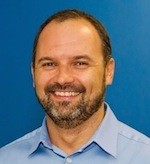Bernhard Rinner | Institute of Networked and Embedded Systems | Alpen-Adria-Universität Klagenfurt, Austria
Abstract: Smart cameras combine video sensing, processing, and communication on a single embedded platform. Networks of smart cameras are real-time distributed embedded systems that perform computer vision using multiple cameras. This new approach has emerged thanks to a confluence of simultaneous advances in four key disciplines: computer vision, image sensors, embedded computing, and sensor networks. Recently these networks have gained a lot of interest in research and industry; applications include surveillance, assisted living and smart environments. In this talk I will introduce some fundamentals of the emerging field of smart camera systems, present selected examples and discuss trends and challenges for future systems.
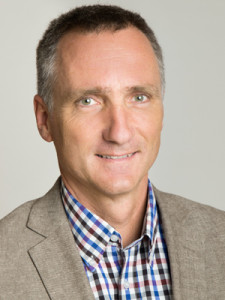 Bio: Bernhard Rinner is professor at the Alpen-Adria-Universität Klagenfurt, Austria where he is heading the Pervasive Computing group. He is deputy head of the Institute of Networked and Embedded Systems and served as vice dean of the Faculty of Technical Sciences from 2008-2011. Before joining Klagenfurt he was with Graz University of Technology and held research positions at the Department of Computer Sciences at the University of Texas at Austin in 1995 and 1998/99.
Bio: Bernhard Rinner is professor at the Alpen-Adria-Universität Klagenfurt, Austria where he is heading the Pervasive Computing group. He is deputy head of the Institute of Networked and Embedded Systems and served as vice dean of the Faculty of Technical Sciences from 2008-2011. Before joining Klagenfurt he was with Graz University of Technology and held research positions at the Department of Computer Sciences at the University of Texas at Austin in 1995 and 1998/99.
His current research interests include embedded computing, sensor networks and pervasive computing. Bernhard Rinner has been co-founder and general chair of the ACM/IEEE International Conference on Distributed Smart Cameras and has served as chief editor of a special issue on this topic in The Proceedings of the IEEE. Currently, he is Associate Editor for Ad Hoc Networks Journal and EURASIP Journal on Embedded Systems. Together with partners from four European universities, he has jointly initiated the Erasmus Mundus Joint Doctorate Program on Interactive and Cognitive Environments (ICE). He is member of IEE and IFIP and member of the board of the Austrian Science Fund.
More Juice Less Bits: MediaMelon Content Aware Streaming [Slides]
Ali C. Begen | MediaMelon, Inc. | IEEE ComSoc Distinguished Lecturer
Abstract: Watching video over the Web is without a doubt the most popular way to access both free and premium content on connected devices for all kinds of consumers from novices to professionals. The underlying technology, called HTTP adaptive streaming, is quite straightforward; however, it does not always result in the most pleasant viewer experience due to quality fluctuations. This can cause dissatisfaction for consumers, leading to revenue loss for providers in both managed and unmanaged video services. In this talk, we will explain a new approach to adaptive streaming that we refer to as Content Aware Streaming. This is not just another adaptive streaming algorithm but a completely untraditional streaming toolset that enables premium viewer experience with minimal cost to the provider. After we briefly cover what solutions have been proposed for existing problems, and what worked and did not work for consumers and providers, we take a stab at clarifying some of the recent public announcements that have been largely misunderstood by the streaming community. Most importantly, we explain why content-based encoding is not the solution by itself to the problems most providers are facing today.
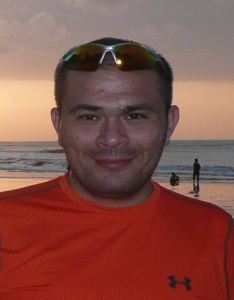 Bio: Ali C. Begen has joined MediaMelon, Inc. as the principal architect for streaming technologies in February 2016, where he is currently heading the development efforts for MediaMelon’s content-aware streaming solutions that enable premium viewer experience while minimizing operational costs and improving profitability. He has been a research and development engineer since 2001, and has broad experience in mathematical modeling, performance analysis, optimization, standards development and intellectual property innovation. Between 2007 and 2015, he was with the Video and Content Platforms Research and Advanced Development Group at Cisco, where he has architected, designed and developed algorithms, protocols, products and solutions in the service provider and enterprise video domains. Since 2007, he has been leading professional and academic projects, and teaching graduate-level courses and giving lectures in universities around the world.
Bio: Ali C. Begen has joined MediaMelon, Inc. as the principal architect for streaming technologies in February 2016, where he is currently heading the development efforts for MediaMelon’s content-aware streaming solutions that enable premium viewer experience while minimizing operational costs and improving profitability. He has been a research and development engineer since 2001, and has broad experience in mathematical modeling, performance analysis, optimization, standards development and intellectual property innovation. Between 2007 and 2015, he was with the Video and Content Platforms Research and Advanced Development Group at Cisco, where he has architected, designed and developed algorithms, protocols, products and solutions in the service provider and enterprise video domains. Since 2007, he has been leading professional and academic projects, and teaching graduate-level courses and giving lectures in universities around the world.
Ali holds a Ph.D. degree in electrical and computer engineering from Georgia Tech. He received a number of scholar and industry awards, and he has editorial positions in prestigious magazines and journals in the field. He is a senior member of the IEEE and a senior member of the ACM. More recently, in January 2016, he was elected as a distinguished lecturer by the IEEE Communications Society. Further information on his projects, publications, keynotes, tutorials, and teaching, standards and professional activities can be found at http://ali.begen.net.
Mulsemedia = multiple sensorial media = novelty or reinvention?
Gheorghita Ghinea | Department of Computer Science | Brunel University, UK
Abstract: Traditionally, multimedia applications have primarily engaged two of the human senses ? the audio and the visual ? out of the five possible. With recent advances in computational technology, it is now possible to talk of applications that engage the other three senses, as well: tactile, olfaction, and gustatory. This integration leads to a paradigm shift away from the old multimedia towards the new mulsemedia : multiple sensorial media. In his talk, Dr. Ghinea is going to focus on the issue of the perceptual experience of mulsemedia and how research in the area has opened new and sometimes challenging opportunities for mulsemedia applications.
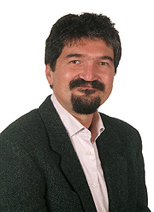 Bio: Dr. Gheorghita Ghinea is a Reader in the School of Information Systems and Computing at Brunel University, United Kingdom. He received the B.Sc. and B.Sc. (Hons) degrees in Computer Science and Mathematics, in 1993 and 1994, respectively, and the M.Sc. degree in Computer Science, in 1996, from the University of the Witwatersrand, Johannesburg, South Africa; he then received the Ph.D. degree in Computer Science from the University of Reading, United Kingdom, in 2000. His research activities lie at the confluence of Computer Science, Media and Psychology. In particular, his work focuses on the area of perceptual multimedia quality and building end-to-end communication systems incorporating user perceptual requirement. He has over 250 publications in leading international conferences and journals; Dr. Ghinea has co-edited two books on Digital Multimedia Perception and Design, and Multiple Sensorial Media Advance and Applications. He leads a team of 8 researchers and consults regularly to both public and private organisations and bodies in his areas of research expertise.
Bio: Dr. Gheorghita Ghinea is a Reader in the School of Information Systems and Computing at Brunel University, United Kingdom. He received the B.Sc. and B.Sc. (Hons) degrees in Computer Science and Mathematics, in 1993 and 1994, respectively, and the M.Sc. degree in Computer Science, in 1996, from the University of the Witwatersrand, Johannesburg, South Africa; he then received the Ph.D. degree in Computer Science from the University of Reading, United Kingdom, in 2000. His research activities lie at the confluence of Computer Science, Media and Psychology. In particular, his work focuses on the area of perceptual multimedia quality and building end-to-end communication systems incorporating user perceptual requirement. He has over 250 publications in leading international conferences and journals; Dr. Ghinea has co-edited two books on Digital Multimedia Perception and Design, and Multiple Sensorial Media Advance and Applications. He leads a team of 8 researchers and consults regularly to both public and private organisations and bodies in his areas of research expertise.
MPEG-DASH Spatial Relationship Description [Paper]
Omar Aziz Niamut | Netherlands Organization for Applied Scientific Research (TNO) | The Netherlands
Abstract: This talk presents the Spatial Representation Description (SRD) feature of the second amendment of MPEG DASH standard part 1, 23009-1:2014. SRD is an approach for streaming only spatial sub-parts of a video to display devices, in combination with the form of adaptive multi-rate streaming that is intrinsically supported by MPEG DASH. The SRD feature extends the Media Presentation Description (MPD) of MPEG DASH by describing spatial relationships between associated pieces of video content. This enables the DASH client to select and retrieve only those video streams at those resolutions that are relevant to the user experience. The paper describes the design principles behind SRD, the different possibilities it enables and examples of how SRD was used in different experiments on interactive streaming of ultra-high resolution video.
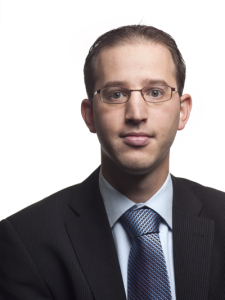 Bio: Omar Aziz Niamut is a senior research scientist at the Netherlands Organization for Applied Scientific Research (TNO), working on shared interactive and immersive media delivery. He received MSc. (2001) and PhD. (2006) degrees from Delft university of Technology. In 2007, he advised and reported to the European Parliament and the European Commission on the harmonisation of mobile TV. From 2008-2010, he made over 300 standardization contributions to ETSI TISPAN and advised the Singapore government on the use of IPTV standards. In 2007, he was the technical lead for one of the world’s first user trial of social TV services and in 2014, he led a joint effort with the BBC towards the world’s first live tiled streaming of UHD video to end users. He has been active as work package lead in EU FP7 projects FascinatE, STEER and EXPERIMEDIA. He has presented at international industry events such as Broadband Home Forum, International Broadcast Convention, IPTV Seminar and IPTV World Forum, NEM Summit and Future Internet Assembly. He is an expert reviewer for the IWT funded iMinds ICON programme and a NEM ETP Steering Board member. He is author of multiple journal papers and conference publications in the fields of audio coding, interactive IPTV services and immersive media, filed 20 patent applications, contributed a chapter to a book on Social TV and co-edited a book on format-agnostic media. He has been serving as Co-chair and main organizer of the WSICC workshop 2013 and 2015, the workshop series (2013, 2014) on cross-breeding social networks and networked media in the Future Internet, and has been appointed as General Co-chair for ACM TVX 2017, the prime venue for publishing research related to TV and online video experiences.
Bio: Omar Aziz Niamut is a senior research scientist at the Netherlands Organization for Applied Scientific Research (TNO), working on shared interactive and immersive media delivery. He received MSc. (2001) and PhD. (2006) degrees from Delft university of Technology. In 2007, he advised and reported to the European Parliament and the European Commission on the harmonisation of mobile TV. From 2008-2010, he made over 300 standardization contributions to ETSI TISPAN and advised the Singapore government on the use of IPTV standards. In 2007, he was the technical lead for one of the world’s first user trial of social TV services and in 2014, he led a joint effort with the BBC towards the world’s first live tiled streaming of UHD video to end users. He has been active as work package lead in EU FP7 projects FascinatE, STEER and EXPERIMEDIA. He has presented at international industry events such as Broadband Home Forum, International Broadcast Convention, IPTV Seminar and IPTV World Forum, NEM Summit and Future Internet Assembly. He is an expert reviewer for the IWT funded iMinds ICON programme and a NEM ETP Steering Board member. He is author of multiple journal papers and conference publications in the fields of audio coding, interactive IPTV services and immersive media, filed 20 patent applications, contributed a chapter to a book on Social TV and co-edited a book on format-agnostic media. He has been serving as Co-chair and main organizer of the WSICC workshop 2013 and 2015, the workshop series (2013, 2014) on cross-breeding social networks and networked media in the Future Internet, and has been appointed as General Co-chair for ACM TVX 2017, the prime venue for publishing research related to TV and online video experiences.
Using Games to solve Challenging Multimedia Problems [Slides]
Oge Marques | Distinguished ACM Speaker | Florida Atlantic University (FAU)
Abstract: There are many challenging problems in multimedia research for which state-of-the-art solutions fall short of performing perfectly. The realization that many of these tasks are arduous for computers yet are relatively easy for humans has inspired many researchers to approach those problems from a human computation viewpoint, using methods that include crowdsourcing and games. The talk discusses how we can use human computation methods to supplement traditional content analysis techniques and assist in the solution of hard multimedia problems.
Oge Marques (http://faculty.eng.fau.edu/omarques/) is Professor of Computer and Electrical Engineering and Computer Science at Florida Atlantic University (FAU) (Boca Raton, Florida). He has more than 25 years of teaching and research experience in the fields of image processing and computer vision. His research interests are in the area of intelligent processing of visual information, which combines the fields of image processing, computer vision, image retrieval, machine learning, serious games, and human visual perception. He is particularly interested in the combination of human computation and machine learning techniques to solve computer vision problems. He is the (co-) author of two patents, more than 100 refereed journal and conference papers, and several books in these topics, including the textbook Practical Image and Video Processing Using MATLAB (Wiley-IEEE Press, 2011). He is Editor-in-Chief (with Borko Furht) of the upcoming 3rd edition of the Encyclopedia of Multimedia (http://encyclopediaofmultimedia.com). He is a senior member of both the ACM and the IEEE and a member of the honor societies of Tau Beta Pi, Sigma Xi, Phi Kappa Phi, and Upsilon Pi Epsilon.

